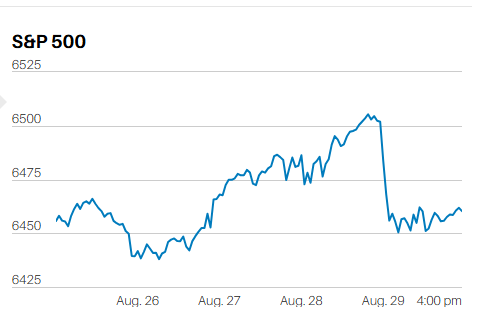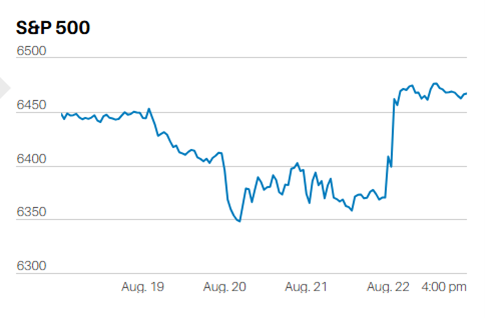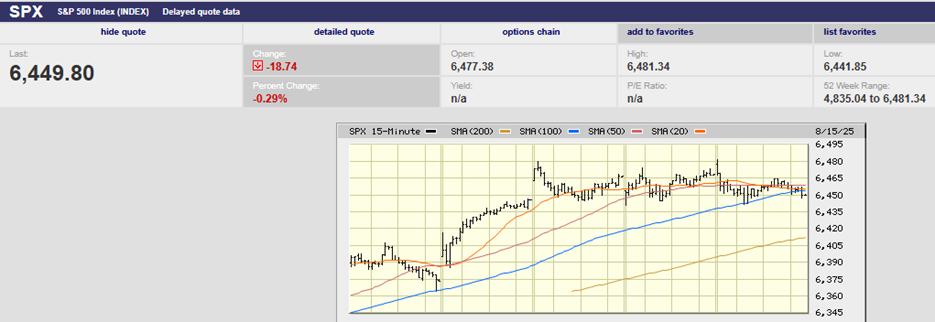Earning a reasonable risk-adjusted return in a market of stocks

Market Update
The S&P 500 lost 1.8% last week to finish at 4419. The Nasdaq lost 2.2% on the week. It is now down about 12% on the year. The S&P 500 is down 7.3%. The Russell 1000 index is down 7.45% on the year while the Russell 1000 Value index is only down 2.48%. The Russell 1000 Growth index is down 12.02% on the year.
(The Russell 1000 index is a large-cap U.S. index used as a benchmark by many mutual fund managers instead of the S&P 500.)
Value continues to outperform growth. Technology stocks continue to struggle. The Select Sector Technology SPDR ETF (XLK) is down 10.92% on the year. What worked so well over the last five years isn’t working now. The S&P looks as if it will test the 4222.62 low set 24 January. The index began an oversold bounce on the 24th, peaking at 4595.31 on 2 February. It consolidated for four trading days before taking a run at the 4595.31 February 2nd high. It failed at 4590.03 on Wednesday. It failed again at 4588.92 on Thursday. Two failures were enough for traders to start selling.
Yes, the media is blaming Thursday’s and Friday’s selling on the inflation number and Russia. No, those aren’t the real reasons. Almost all short-term market movements are the result of technical factors. Fundamentals only matter over the long run. The S&P was running into selling at 4590 so traders pivoted and joined in the selling. It really is as simple as that.
A short-term double top is in place and the S&P 500 has closed below its 200-day moving average again. The most likely short-term direction is down with a retest of the 4222.62 low likely in the next week or two. Conditions are right for a full-blown correction. It’s anyone’s guess whether that’s what we are experiencing now. Investors shouldn’t be surprised if the selling in the S&P 500 continues though.
Interest rates continue to move higher. The 2-year Treasury finished the week at 1.55%. The 10-year ended the week at 1.94% and the 30-year at 2.26%. The yield curve continues to flatten. The flattening yield curve is getting frequent mention, more than it deserves. The 3-month T-bill is yielding 0.37%. The spread between it and the 10-year Treasury is 1.57% and it is that spread which is relevant. The New York Fed uses the 10 yr – 3 mth spread in its model to predict recessions two to six quarters ahead. The current 1.56% spread is above the year-ago spread of 1.11%. In other words, the yield curve is steeper than a year ago.
Norwood Economics continues to expect a 10% to 15% pullback in the S&P 500. We do not think a bear market is in the cards for 2022. Nor is a recession likely until the second half of 2023 at the earliest.
Economic Indicator
Inflation remains at the highest level since 1981. The NFIB Small Business Association’s latest survey shows small business raising average prices more than any time since 1974. Inflation was reported as the single biggest problem by 22% of owners responding to the survey. The small business optimism index fell from 98.9 to 97.1 in January. The CPI rose 7.5% year-over-year. The core CPI which excludes food and energy rose 6.0%.
High and rising inflation explains poor consumer sentiment readings. The University of Michigan consumer sentiment index dropped to 61.7 from 67.2. Consumer sentiment has fallen 19.7% from last February. The impact of higher inflation on personal finances was cited by one-third of consumers, according to the survey. Nearly half of consumers expect declines in their inflation-adjusted incomes. The sharp drop in consumer sentiment is at levels that have signaled an impending recession in the past.
An Inefficient Market
The stock market is not efficient. The Efficient Market Hypothesis does not withstand the data. There is no rational explanation for the S&P 500’s price in late 1999 and early 2000. It was trading at a price that ensured no returns for a decade, which is exactly what happened. Furthermore, there were half a dozen metrics in 2000 predicting the negative 10-year return. Few chose to believe those metrics. The S&P 500 subsequently returned zero from March of 2000 until the middle of 2013.
The same metrics are forecasting a low single-digit return for the next decade. A low single-digit return for the stock market does not necessarily mean a low single-digit return for your stock portfolio. Avoiding expensive stocks and buying the cheap stocks can allow an investor to earn a reasonable risk-adjusted return. It is a market of stocks not a stock market. The Efficient Market Hypothesis does not withstand scrutiny for the stock market. Logically, it does not withstand scrutiny for individual stocks either.
AT&T is a case in point. The stock traded between 24.06 and 26.98 on 26 January. AT&T fell 10.8% from high to low that day. The media claimed the volatility was due to comments made by CEO John Stankey. Yet, Stankey said nothing that wasn’t already well known. I’ve read dozens of articles analyzing the spin-off of Time/Warner and its merger with Discovery. A spin-off rather than a split-off was always almost a certainty. Split-offs are rare in any case. The dividend cut was well telegraphed also and had been known by the market for many months.
Nothing about the trading on 26 January indicated an efficient market. Clearly many AT&T investors were caught by surprise on the 26th. And that despite the information being in the public domain for months.
Norwood Economics buys good companies on sale. Companies go on sale because the stock market is manifestly not efficient. Thank goodness for that!
Regards,
Christopher R Norwood, CFA
Chief Market Strategist











